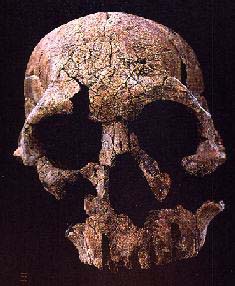 What distinguishes Homo habilis from Australopithicus is it's increased cranial size. The range of cranial volume is more than 500 cm3 to almost 800 cm3. This is 21 % increase form the Australopithecines 520 cm3. The cranium has thin rounded walls that reflect the increased brain size. The bottom of the cranium is shortened from the back of the palate to the occipital bone.
What distinguishes Homo habilis from Australopithicus is it's increased cranial size. The range of cranial volume is more than 500 cm3 to almost 800 cm3. This is 21 % increase form the Australopithecines 520 cm3. The cranium has thin rounded walls that reflect the increased brain size. The bottom of the cranium is shortened from the back of the palate to the occipital bone.
Homo habilis had facial appearances similar to those of Australopithecus seen in Olduvai specimens. These are prominent cheekbones and a flattened nasal area. What is significant is that in later specimens the nasal area becomes more protruding, seen in specimen ER 1813 from Koobi Fora. The dentition of Homo habilis shows narrowing of the premolars and molar crowns. The jaws are smaller but still robust.
 There has been very little postcranial material found that can give a concrete picture of how tall or what body shape Homo habilis had. Due to the dificult fosilization of the skeleton of postcranial material. Specimen OH62 from Olduvai Gorge contained an arm bone, which suggests by its length that their arms were ape-like. Specimen OH7 from Olduvia Gorge is that of an immature hand which suggests the ability to manipulate objects.
There has been very little postcranial material found that can give a concrete picture of how tall or what body shape Homo habilis had. Due to the dificult fosilization of the skeleton of postcranial material. Specimen OH62 from Olduvai Gorge contained an arm bone, which suggests by its length that their arms were ape-like. Specimen OH7 from Olduvia Gorge is that of an immature hand which suggests the ability to manipulate objects.